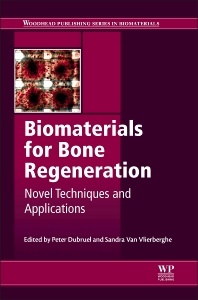Description
Biomaterials for Bone Regeneration
Novel Techniques and Applications
Woodhead Publishing Series in Biomaterials Series
Coordinators: Dubruel P., Van Vlierberghe S.
Language: English
Subjects for Biomaterials for Bone Regeneration:
Publication date: 10-2018
502 p. · 15.5x23.2 cm · Paperback
Publication Abandoned
Publication date: 06-2014
502 p. · 15.5x23.2 cm · Hardback
Out of Print
Description
/li>Contents
/li>Readership
/li>Biography
/li>Comment
/li>
Novel Biomaterials for Bone Regeneration provides a comprehensive review of currently available biomaterials and how they can be applied in bone regeneration. In recent decades, there has been a shift from the idea of using biomaterials as passive substitutes for damaged bones towards the concept of biomaterials as aids for the regeneration of a host's own bone tissue. This has generated an important field of research and a range of technological developments.
Part one of this book discusses a wide range of materials, including calcium phosphate cements, hydrogels, biopolymers, synthetic polymers, and shape memory polymers. Part two then turns to the processing and surface modification of biomaterials, as well as how biomaterials can be evaluated both for their mechanical properties and for immunocompatibility with the host. Finally, part three covers a variety of cellular approaches, and production and delivery of biomaterials for bone regeneration. Chapters also consider the potential of electromagnetic and ultrasonic stimulation of biomaterials to aid in the regenerative process.
Novel Biomaterials for Bone Regeneration represents an important resource for academics, clinicians, and industry professionals working in the area of biomedical materials, providing them with both an overview of the current state-of-the-art, and an indication of potential future developments.
Foreword Part I Materials for bone regeneration 1 Calcium phosphate cements for bone regeneration G. Cama, King’s College London, UK 2 Injectable calcium phosphate cements for spinal bone repairR. O’Hara, F. Buchanan and N. Dunne, Queen's University of Belfast, UK 3 Hydrogels for bone regeneration I. C. Stancu, A. Lungu and H. Iovu, University Politehnica of Bucharest, Romania 4 Combinations of biopolymers and synthetic polymers for bone regeneration A. T. Neffe, K. K. Julich-Grunerand A. Lendlein, Institute of Biomaterial Science and Berlin-Brandenburg Center for Regenerative Therapies, Helmholtz-Zentrum Geesthacht, Germany 5 Applications of shape memory polymers (SMPs) in mechanobiology and bone repair J. H. Henderson, K. A. Davis and R. M. Baker, Syracuse University, USA Part II Processing, surface modification and evaluation of biomaterials for bone regeneration 6 Photopolymerization-based additive manufacturing for the development of 3D porous scaffolds B. Husár and M. Hatzenbichler, Vienna University of Technology (TU Wein), Austria, V. Mironov, Center for Information Technology Renato Archer (CTI), Brazil, R. Liska, J. Stampfl, Vienna University of Technology (TU Wein), Austria and Austrian Research Cluster for Tissue Regeneration, Austria and A. Ovsianikov, Vienna University of Technology (TU Wein), Austria and Austrian Research Cluster for Tissue Regeneration, Austria 7 Cold plasma surface modification of biodegradable polymer biomaterials N. De Geyter and R. Morent, Ghent University, Belgium 8 In vitro analysis of magnesium corrosion in orthopaedic biomaterials F. Feyerabend, Helmholtz-Zentrum Geesthacht, Germany 9 Evaluating the mechanical properties of biomaterials M. Capurro and F. Barberis, University of Genoa, Italy 10 Assessing immunological properties of biomaterials for bone regeneration applications M. Sirova, Institute of Microbiology ASCR, Czech Republic Part III Cellular approaches and physical stimulation of biomaterials for bone regeneration applications 11 Polymeric and liposomal nanocarriers for controlled drug delivery A. Karewicz, Jagiellonian University, Poland 12 Gene transfer vectors (DNA vehicles) and their incorporation into biomaterials for bone repair T. Wirth and S. Ylä-Herttuala, University of Eastern Finland, Finland 13 Stem cell technology for in vitro bone tissue engineering H. Declercq and M. Cornelissen, Ghent University, Belgium 14 Stem cell technology for in vivo bone repair M. Helder, VU University Medical Center, MOVE Research Institute Amsterdam, The Netherlands and A. Bakker, Academic Centre for Dentistry Amsterdam, University of Amsterdam and VU University Amsterdam, MOVE Research Institute Amsterdam, The Netherlands 15 Potential of electromagnetic and ultrasound stimulations for bone regeneration L. Fassina, University of Pavia, Italy, P. Dubruel, University of Ghent, Belgium, G. Magenes, University of Pavia, Italy and S. Van Vlierberghe, University of Ghent, Belgium
Biomaterials for bone regeneration is an important resource for academics, clinicians and industry professionals working in the area of biomedical materials, and will provide them with both an overview of the current state-of-the-art, and an indication of potential future developments.
Professor Van Vlierberghe is active in the same group and the spokesperson of the Young Scientist Forum (YSF) of the European Society for Biomaterials.
- Provides comprehensive coverage of novel materials, techniques, and applications of biomaterials for bone regeneration
- Provides vital information on the various types of materials used in bone regeneration
- Discusses processing, modification, and evaluation techniques of biomaterials, and looks at cellular approaches and stimulation of biomaterials for bone regeneration
These books may interest you

Biomaterials for Spinal Surgery 253.24 €



